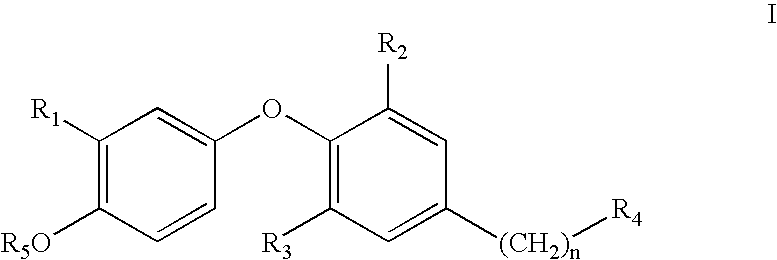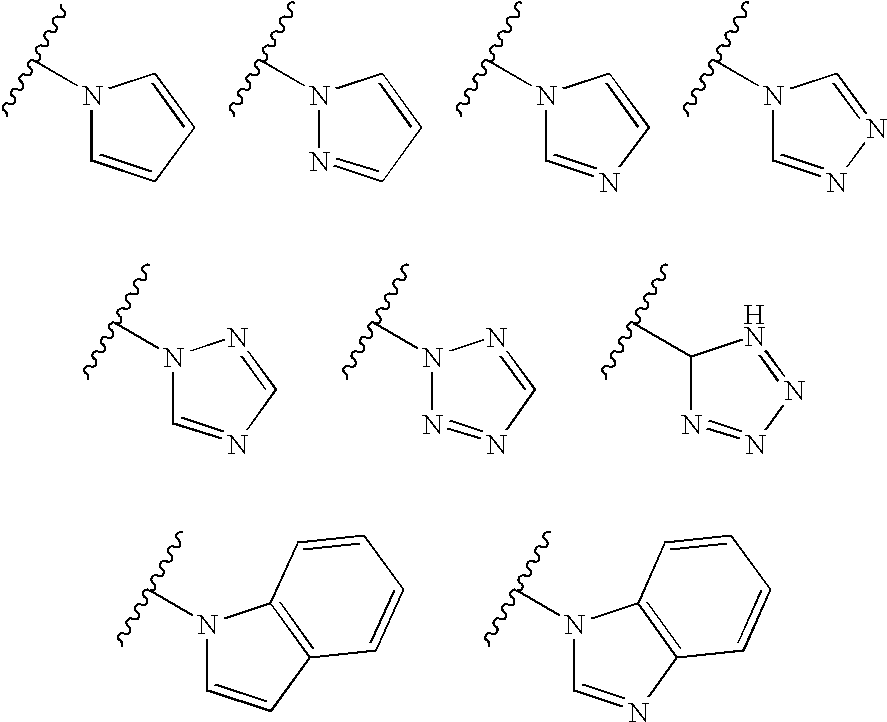Thyroid receptor ligands and method II
a thyroid hormone and receptor technology, applied in the field of compounds, can solve the problems of limited development of thyroid hormone agonists and antagonists for treatment, slow discovery and development of new specific drugs for improving the treatment of hyperthyroidism and hypothyroidism, and weight loss
- Summary
- Abstract
- Description
- Claims
- Application Information
AI Technical Summary
Benefits of technology
Problems solved by technology
Method used
Image
Examples
example 1
3,5-Dimethyl-4-(4-hydroxy-3-isopropylphenoxy)benzyltetrazole
[0076]To a stirred solution of 3,5-dimethyl-4-(4-hydroxy-3-isopropylphenoxy)-phenylacetonitrile (154 mg) in 6.3 ml of dimethyl formamide, ammonium chloride (297 mg, 5.21 mmol) and sodium azide (339 mg, 5.21 mmol) was added at reflux. After 4.5 hours the reaction mixture was concentrated, treated with 6 M hydrochloric acid and extracted several times with ethyl acetate. The combined organic phases were dried over magnesium sulphate, filtered and concentrated. The residue was purified by column chromatography (silica gel, 96:4:1 chloroform / methanol / acetic acid) to give 68 mg (37%) of the title compound.
example 2
3,5-Dichloro-4-(4-hydroxy-3-isopropylphenoxy)benzyltetrazole
[0077](a) To a stirred solution of 3,5-dichloro-4-(4-methoxy-3-isopropylphenoxy)-phenylacetonitrile (160 mg) in 3.0 ml of dimethyl formamide, ammonium chloride (500 mg) and sodium azide (600 mg) was added at reflux. After 2 hours the reaction mixture was concentrated, treated with 6 M hydrochloric acid and extracted several times with ethyl acetate. The combined organic phases were dried over magnesium sulphate, filtered and concentrated. The residue was purified by column chromatography (silica gel, 96:4:1 chloroform / methanol / acetic acid) to give 60 mg (34%) of 3,5-dichloro-4-(4-methoxy-3-isopropylphenoxy)benzyltetrazole.
[0078](b) A reaction mixture of 3,5-dichloro-4-(4-methoxy-3-isopropylphenoxy)-benzyltetrazole (60 mg), BF3.Me2S (0.5 ml) and CH2Cl2 (6 ml) was stirred at room temperature over night. The yield after purification was quantitative.
examples 3 – 24
EXAMPLES 3–24
[0079]
General Procedure
[0080]A mixture of 3,5-dibromo-4-(4-hydroxy-3-isopropylphenoxy)phenylacetic acid (222 mg), 3-ethyl-1-[3-(dimethylamino)propyl]carbodiimide hydrochloride (EDCI), (95 mg), 1-hydroxybenzotriazole hydrate (HBT), (91 mg), in dichloromethane (5 ml) was stirred under argon at room temperature for 2 h. In a separate flask, the appropriate amino acid, triethylamine (100 mg) and 5 ml of dichloromethane was stirred for 1 h under N2. The two mixtures were combined and the reaction mixture stirred at 40° C. over night. When the starting carboxylic acid was consumed, the organic phase was removed in vacuo and the residue dissolved in methanol (20 ml) and 1N NaOH (10 ml). The reaction mixture was stirred at 40° C. for 24 h and evaporated. The residue was subjected to semi-preparative HPLC, using gradient elution as outlined below. The amine part “R”, and the stereochemistry of the aminoacids is indicated in the table below.
[0081]1HPLC retention time in minutes a...
PUM
| Property | Measurement | Unit |
|---|---|---|
| flow rate | aaaaa | aaaaa |
| flow rate | aaaaa | aaaaa |
| temperature | aaaaa | aaaaa |
Abstract
Description
Claims
Application Information
 Login to View More
Login to View More - R&D
- Intellectual Property
- Life Sciences
- Materials
- Tech Scout
- Unparalleled Data Quality
- Higher Quality Content
- 60% Fewer Hallucinations
Browse by: Latest US Patents, China's latest patents, Technical Efficacy Thesaurus, Application Domain, Technology Topic, Popular Technical Reports.
© 2025 PatSnap. All rights reserved.Legal|Privacy policy|Modern Slavery Act Transparency Statement|Sitemap|About US| Contact US: help@patsnap.com



